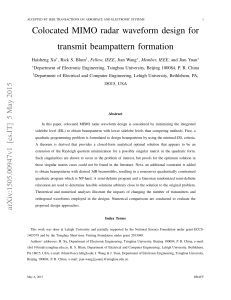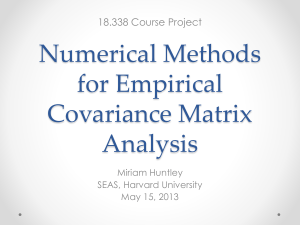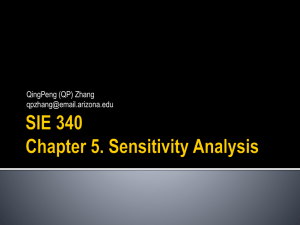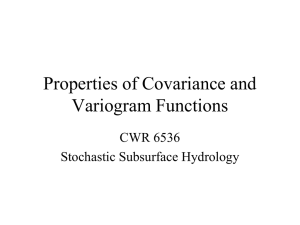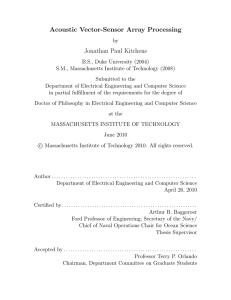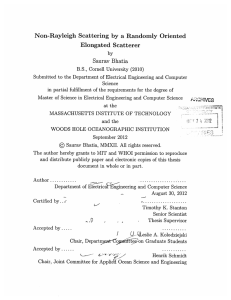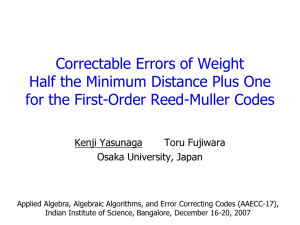Chapters 13 to 14
advertisement
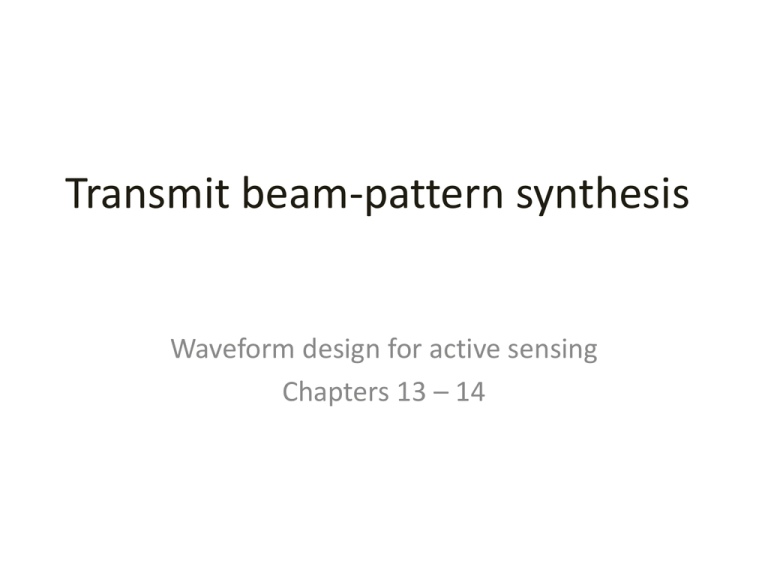
Transmit beam-pattern synthesis Waveform design for active sensing Chapters 13 – 14 Introduction • Problem Receive beampattern === transmitt beampattern (technical issues !! ) MIMO radar Beam-pattern to covariance M Signal at target: e i 2 f o m x m ( n ) a ( ) x ( n ) H m 1 x ( n ) x1 ( n ), x 2 ( n ), i 2 f o 1 ( ) a ( ) e , P ( ) a ( ) R a ( ) H R E x ( n ) x ( n ) H xM (n ) ,e i 2 f o M ( ) Power at a specific . P ( ) a ( ) R a ( ) H The power constraint The transmit beampattern can be designed by chosing R. Rmm c ( Individual radiator) M tr ( R ) c ( Total Power ) Goals: Match a transmit beam pattern. 2. Minimize cross correlation between probing signals. 3. Minimize sidelobe level. 4. Achieve a required main-bem bandwidth. 1. For a MIMO radar with K targets. K y (n) k a ( k )a ( k ) x ( n ) ε ( n ) * H k 1 A correlated scattered signal will create ambiguities!! How to design the signal x knowing R ? x(n) R 1/ 2 w (n) When the covariance matrix of w is the identity matrix. Optimal Design Assume K targets of interest K K K a ( k ) Ra ( k ) tr ( R B ) H k 1 K B k 1 a ( k ) a ( k ) H If there is no information on the target locations J m ax m in tr ( R B ) Optimize for J R s .t . B Rmm c , m 1, ,M . M R 0, B 0 With tr ( R ) c R solution is: c M I The MIMO radar creates a spacially white signal. Optimal Design for known target locations • An estimate B of B is available. J m ax tr ( R B ) The problem becomes: R s .t . tr ( R ) c R 0 However: tr ( R B ) m ax ( B ) tr ( R ) c m ax ( B ) R cu u H is the left eigenvector of B Problems with previous design: • Element power uncontrolled. • Power reaching each target uncontrolled. • No controll in Cross-correlation Any design with phase shifted array will have coherent target scattering. Advantage : • The same approach maximizes SINR. (different B) Beam pattern matching design & cross-correlation minimization Assume a desired beam pattern A L-targets located at Are weigths to the cost function. Allows matching a scaled version of the beampattern. Previous problem is a SQP Having r the vector of Rmm and Rmp This can be solved using SQP solvers ! How to obtain ? Use: 1. A spatially white signal . 2. Use the Generalized likelyhood ratio test (GLRT) and/or CAPON. GLRT, has good features for target detection, jammer avoidance, and tradeoff betwen robustness and resolution. Minimun sidelobe beampattern design Interestingly a relaxation seems to produce better solution than the strict! Phase array beampattern • All the radiators contain the same scaled version of the signal x. • Problem becomes non-convex = > hard!! Introduce a constraint An approach is to use the same solution as MINO (relaxed version) followed by a Newton-like algorithm. Numerical example 3 targets: 0o, -40o and 40o. Strong jammer at 25o CAPON technique Using =1 = 0. Beampattern design (robust phase) Beampattern design (robust phase) Using phase shifted array Reducing the cross-correlation Effect of sample covariance matrix Having R a design of x ? The sample covariance of w has to be identity….. Error 1000 Monte-Carlo Minimun sidelobe level design MIMO array Phase array Relax the individual energy constraint from 80% to 120% c/M while the total energy is still fixed. Covariance to Matrix Wavefrom The uni-modular constraint can be replaced by a low PAR. This with a energy constraint will produce: Assume: x1 (1) X x (N ) 1 Sample covariance x M (1) x M ( N ) Result of unconstraint minimization We need to include good correlation properties: With this notation the goal is: Using the idea of decomposing X into two matrix multyiplication then we can solve: Thus: • For unimodular signal design === MultiCAO replaced • For low PAR constraint CA algorithm Constraining the PAR becomes the independent minimization problems With the ”p-th” element of z as: Numerical Results M=10 P=1 N = 256 M=10 P=10 N = 256 M=10 P=1 N = 256 M=10 P=10 N = 256
